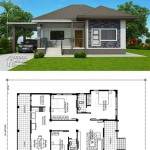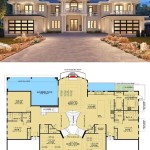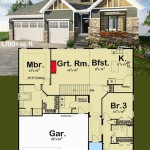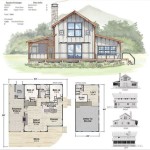House plans without garage are residential designs that exclude a dedicated space for parking vehicles within the structure. They offer a unique approach to home design, prioritizing space optimization and alternative parking solutions while catering to specific lifestyle choices and preferences.
In urban areas with limited space or high land costs, houses without garages have become increasingly popular. They allow homeowners to maximize their living space without compromising on comfort or functionality. Additionally, these plans can be more environmentally friendly, reducing energy consumption and minimizing the need for additional land for parking.
As we explore the various advantages and considerations of house plans without garage, it’s important to understand the different types available, the design principles involved, and the practical implications of choosing such a home design.
House plans without garage offer a range of advantages and considerations. Here are nine important points to keep in mind:
- Maximize space utilization
- Reduce construction costs
- Lower energy consumption
- Promote alternative parking solutions
- Enhance curb appeal (in some cases)
- Accommodate specific lifestyle choices
- Consider parking availability and accessibility
- Explore alternative storage options
- Design with security and safety in mind
By carefully considering these points, homeowners can make informed decisions about whether a house plan without garage is the right fit for their needs and preferences.
Maximize space utilization
One of the key advantages of house plans without garage is the ability to maximize space utilization. By eliminating the need for a dedicated parking space within the structure, homeowners can allocate that space to other functional areas of the home, such as additional living space, bedrooms, storage, or outdoor living areas.
- Increased living space: Without a garage, the square footage of the home can be dedicated to living areas, creating more spacious and comfortable interiors. This is particularly beneficial for homes on smaller lots or in urban areas where space is at a premium.
- Additional bedrooms or bathrooms: The space saved by eliminating the garage can be used to add extra bedrooms or bathrooms, increasing the functionality and value of the home.
- Expanded storage: Instead of a garage, homeowners can incorporate dedicated storage spaces throughout the house, such as closets, pantries, or mudrooms, maximizing storage capacity without sacrificing living space.
- Enhanced outdoor living: The area that would have been occupied by a garage can be transformed into an outdoor living space, such as a patio, deck, or garden, extending the living space beyond the walls of the home.
By maximizing space utilization, house plans without garage allow homeowners to create homes that are tailored to their specific needs and lifestyles, without compromising on comfort or functionality.
Reduce construction costs
House plans without garage offer significant cost savings compared to traditional home designs with garages. Eliminating the garage from the building plans reduces the overall square footage of the home, which directly translates to lower construction costs. This is especially advantageous in areas where land and building costs are high.
The cost savings extend beyond the initial construction phase. Garages require additional materials, such as concrete for the foundation and framing for the walls and roof. They also require insulation, drywall, and a garage door, all of which add to the overall cost of the home. By eliminating these components, homeowners can save a substantial amount of money.
Furthermore, garages often require additional electrical work for lighting and outlets, as well as plumbing for sinks or utility areas. These additional expenses are eliminated in house plans without garage, further reducing construction costs.
In addition to the direct cost savings, house plans without garage can also lead to indirect cost savings. For example, homes without garages may have lower energy costs due to reduced heating and cooling needs. They may also require less maintenance and repairs over time, as there is no garage door or garage roof to maintain.
Overall, house plans without garage offer a cost-effective solution for homeowners looking to build a new home without sacrificing functionality or comfort.
Lower energy consumption
House plans without garage offer significant potential for lower energy consumption compared to traditional home designs with garages. Garages are typically uninsulated and poorly sealed, leading to heat loss in the winter and heat gain in the summer. By eliminating the garage, homeowners can reduce the overall energy consumption of their homes.The reduced square footage of a home without a garage means less space to heat and cool. This can lead to significant savings on heating and cooling costs, especially in extreme climates. Additionally, homes without garages have a smaller surface area exposed to the outside environment, reducing heat transfer and energy loss.Furthermore, house plans without garage often incorporate passive design principles to maximize energy efficiency. These principles include optimizing window placement for natural lighting and ventilation, using high-performance insulation, and designing for thermal mass to regulate indoor temperatures. By incorporating these principles, homeowners can further reduce their energy consumption and create a more comfortable and sustainable living environment.In addition to the direct energy savings, house plans without garage can also lead to indirect energy savings. For example, homes without garages may require less artificial lighting due to increased natural light from windows. They may also have reduced water consumption, as there is no need to wash a car in the garage.Overall, house plans without garage offer a more energy-efficient solution for homeowners looking to build a sustainable home without sacrificing functionality or comfort.
Promote alternative parking solutions
House plans without garage necessitate the exploration of alternative parking solutions to accommodate vehicles. This can be achieved through a variety of creative and practical approaches, including:
Driveways: Driveways provide a convenient and direct parking option for homes without garage. They can be designed to accommodate one or more vehicles, and can be paved with a variety of materials such as concrete, asphalt, or pavers. Driveways should be designed with proper drainage to prevent water accumulation and potential damage to vehicles.
Carports: Carports offer a covered parking option without the enclosed structure of a garage. They provide protection from the elements, such as rain, snow, and sun, while still allowing for ventilation. Carports can be freestanding or attached to the home, and can be customized to fit the specific needs and aesthetic preferences of the homeowner.
On-street parking: In urban areas or neighborhoods with limited space, on-street parking may be the only viable option for homes without garage. Homeowners should be aware of local parking regulations and restrictions, and may need to obtain a permit or pay for street parking.
Public transportation: For homeowners who do not own a vehicle or who rely primarily on public transportation, house plans without garage can be an excellent choice. Public transportation options, such as buses, trains, and subways, can provide convenient and affordable access to work, school, and other destinations.
Bicycle storage: For homeowners who commute by bicycle or who enjoy recreational cycling, house plans without garage can incorporate dedicated bicycle storage areas. This can include bike racks, bike sheds, or even indoor storage spaces, encouraging a healthy and environmentally friendly mode of transportation.
By exploring these alternative parking solutions, homeowners can design house plans without garage that meet their specific needs and lifestyles, while also promoting sustainable and space-efficient living practices.
Enhance curb appeal (in some cases)
Whether a house plan without garage enhances curb appeal is a matter of personal preference and architectural style. However, there are certain design considerations that can contribute to an aesthetically pleasing and visually appealing home without a garage.
Architectural style: Certain architectural styles, such as modern, contemporary, and minimalist, often incorporate house plans without garage as a key design element. These styles emphasize clean lines, open spaces, and a seamless integration between indoor and outdoor living areas. By eliminating the garage, architects can create a more streamlined and visually striking exterior.
Landscaping: Landscaping plays a crucial role in enhancing the curb appeal of house plans without garage. By incorporating well-manicured lawns, colorful flowerbeds, and mature trees, homeowners can draw attention to the home’s architectural features and create a visually appealing streetscape. Strategically placed landscaping can also help to conceal the lack of a garage and create a more cohesive overall design.
Facade design: The facade of a house without a garage becomes a focal point of the exterior design. Homeowners can enhance curb appeal by using a variety of materials, textures, and colors to create a visually interesting and inviting entryway. This can include stone accents, wood siding, large windows, and decorative elements such as columns or moldings.
Outdoor living spaces: By eliminating the garage, homeowners can create additional outdoor living spaces, such as patios, decks, or courtyards. These spaces can be designed to complement the home’s architectural style and provide an extension of the living area outdoors. By incorporating outdoor furniture, lighting, and landscaping, homeowners can create a welcoming and visually appealing outdoor space that enhances the overall curb appeal of the home.
Overall, while house plans without garage may not always enhance curb appeal in traditional terms, they offer unique design opportunities to create visually striking and architecturally interesting homes. By carefully considering architectural style, landscaping, facade design, and outdoor living spaces, homeowners can design house plans without garage that enhance curb appeal and create a home that is both functional and aesthetically pleasing.
Accommodate specific lifestyle choices
House plans without garage can be tailored to accommodate a wide range of specific lifestyle choices and preferences. By eliminating the garage, homeowners can create homes that are uniquely suited to their needs and aspirations.
- Urban living: In urban areas where space is at a premium and parking can be limited, house plans without garage offer a practical and space-efficient solution. Homeowners can enjoy the benefits of urban living, such as proximity to amenities and public transportation, without sacrificing the comfort and functionality of a home.
- Sustainability and environmental consciousness: For homeowners who are environmentally conscious and prioritize sustainability, house plans without garage can contribute to a greener lifestyle. By reducing the overall footprint of the home and eliminating the need for a car-centric lifestyle, homeowners can minimize their environmental impact.
- Focus on outdoor living: House plans without garage can provide more opportunities for outdoor living and connection with nature. The space that would have been occupied by a garage can be repurposed to create outdoor living areas, such as patios, decks, or gardens, allowing homeowners to enjoy the benefits of outdoor recreation and relaxation.
- Unique architectural designs: Eliminating the garage from the design process opens up a range of unique architectural possibilities. Architects can explore innovative and creative designs that may not be feasible with traditional house plans with garage. This can result in homes that are visually striking, architecturally interesting, and tailored to the specific tastes and preferences of the homeowners.
Overall, house plans without garage offer a flexible and adaptable solution for homeowners who seek to create homes that reflect their unique lifestyles, values, and aspirations.
Consider parking availability and accessibility
When considering house plans without garage, it is crucial to carefully evaluate the availability and accessibility of parking. The absence of a dedicated parking space within the structure means that alternative parking solutions must be explored to accommodate vehicles.
Homeowners should assess the on-street parking situation in their neighborhood. Is there ample street parking available, or is it limited and competitive? Are there any parking restrictions or permit requirements that need to be considered? If on-street parking is not a viable option, homeowners may need to explore other alternatives, such as renting or purchasing a parking space in a nearby garage or lot.
Another important factor to consider is the accessibility of the parking solution. If the alternative parking is located a significant distance from the home, it may be inconvenient or impractical for daily use. Homeowners should consider the distance, terrain, and lighting conditions when evaluating the accessibility of alternative parking options.
In some cases, homeowners may opt to create a dedicated parking space on their property, such as a driveway or carport. However, this may require additional construction costs and may not be feasible due to space limitations or zoning restrictions. It is important to research local regulations and consult with professionals to determine the feasibility and cost implications of creating a dedicated parking space on the property.
By carefully considering parking availability and accessibility, homeowners can make informed decisions about whether a house plan without garage is the right fit for their needs and lifestyle. It is essential to weigh the convenience of having a dedicated parking space within the structure against the potential cost savings and other benefits of eliminating the garage.
Explore alternative storage options
House plans without garage require careful consideration of alternative storage options to accommodate belongings and maintain a clutter-free living space. Here are four practical and innovative ways to maximize storage in homes without garages:
Utilize vertical space: Make the most of vertical space by installing shelves, cabinets, and drawers on walls and in closets. Utilize stackable bins and containers to organize items vertically, maximizing storage capacity and minimizing floor space usage.
Multipurpose furniture: Incorporate furniture pieces that serve multiple functions, such as ottomans with built-in storage, coffee tables with drawers, and beds with storage compartments. These versatile pieces provide both seating and storage solutions, optimizing space utilization.
Outdoor storage: If feasible, consider adding outdoor storage sheds or cabinets to store seasonal items, gardening equipment, and bulky belongings. Outdoor storage can free up valuable indoor space while keeping frequently used items easily accessible.
Creative storage solutions: Explore unconventional storage ideas, such as under-bed storage containers, hanging organizers for closets, and magnetic strips for storing knives and tools. These innovative solutions utilize often-overlooked spaces, maximizing storage capacity without sacrificing aesthetics or comfort.
By implementing these alternative storage options, homeowners can create functional and organized living spaces in house plans without garage. Careful planning and creative thinking can ensure that all belongings are stored efficiently and conveniently, maintaining a clutter-free and comfortable home environment.
Design with security and safety in mind
When designing house plans without garage, it is paramount to prioritize security and safety measures to ensure the well-being of occupants and the protection of property. Here are four key considerations for enhancing security and safety in homes without garages:
Secure entry points: All entry points to the home, including doors and windows, should be equipped with high-quality locks and reinforced frames. Consider installing deadbolts, security bars, and alarms on doors and windows to deter unauthorized entry. Additionally, motion-sensor lights can be placed around entry points to illuminate suspicious activity and deter potential intruders.
Visibility and surveillance: Good visibility around the home can act as a deterrent to crime. Keep landscaping trimmed and avoid planting dense shrubs that can provide hiding places for intruders. Install outdoor lighting to illuminate dark areas and make the property less appealing to potential burglars. Additionally, consider installing security cameras to monitor activity around the home and provide evidence in the event of a security breach.
Secure storage areas: Valuables and important documents should be stored in a secure location within the home, such as a safe or a locked cabinet. Avoid leaving valuables in plain sight or in easily accessible areas. Additionally, consider installing security features in outdoor storage sheds or cabinets to protect tools and equipment from theft.
Emergency preparedness: In the event of an emergency, such as a fire or natural disaster, it is crucial to have a plan in place and to ensure that all occupants know the evacuation routes. Keep emergency supplies, such as a first-aid kit, flashlight, and battery-powered radio, in easily accessible locations. Additionally, consider installing smoke and carbon monoxide detectors throughout the home to alert occupants to potential hazards.
By incorporating these security and safety measures into house plans without garage, homeowners can create a secure and protected living environment for themselves and their families.










Related Posts








